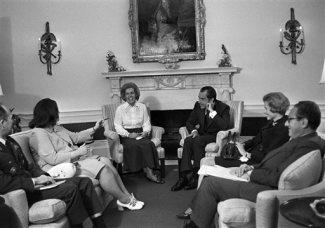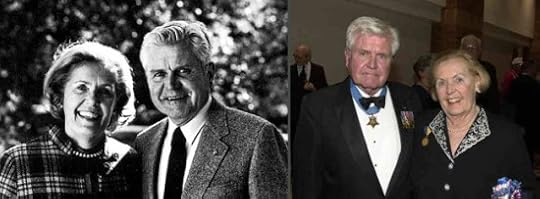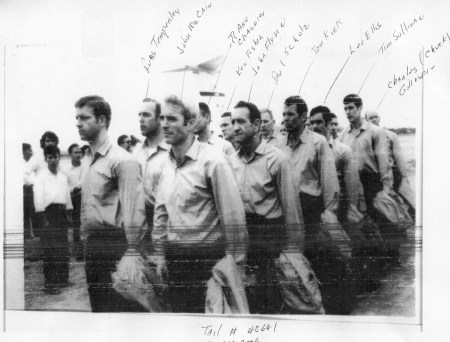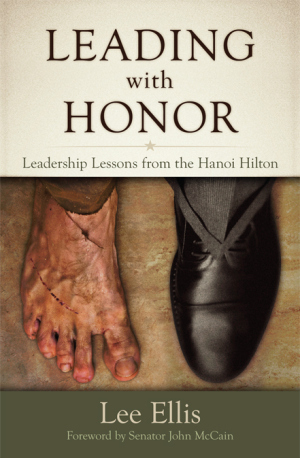Lee Ellis's Blog, page 292
October 27, 2015
Honorable Leaders at SOS Maxwell AFB
I had a fantastic experience with these Squadron Officer School (SOS) commanders and key staff at last weekend’s warrior symposium. It was such an honor to present my leadership stories and experience. Grateful for these honorable leaders!


Thank You Terry for Leading with Honor Comments
Thanks to Terry for your enthusiastic review of Leading with Honor –
“Unbelieveable what [the Vietnam POWs] had to endure and for so long! I learned a lot from this book.”


October 26, 2015
Discover the Natural Behaviors of Your Team – Leadership Behavior DNA
What are your natural leadership behaviors? How about your team? Lee Ellis has an entirely separate training services division called Leadership Behavior DNA™?
Based on more than 30 years of research and experience in developing leaders, it focuses on some of the key behavioral issues of leadership, helping managers adapt their leadership style to help each person reach their full potential.
Watch Lee introduce this suite of services.


October 25, 2015
On This Day in Leadership History, October 25, 2015
On this day in leadership history in 1955, The Tappan Company introduced the microwave oven for home use. Just think how this product eventually revolutionized every home in America. How can you re-think a strategy or way of accomplishing your work that could change the trajectory of your goals? Step out of the day-to-day process and evaluate a new way of leading and working!
Tappan Bran – Wikipedia


October 24, 2015
Who’s the Honorable Leader on Election Day 2015? See Inside
 Time is approaching for Election Day 2015! How will you vote on your local, regional, and state elections this year?
Time is approaching for Election Day 2015! How will you vote on your local, regional, and state elections this year?
Download a free copy of the non-partisan Leading with Honor Voter Evaluation Guide to help you determine the best candidate for public office.
And please share your comments in this forum on the most important leadership attribute for our public servants.


October 23, 2015
Leading with Honor Wisdom for Today, October 23, 2015
“You don’t inspire your teammates by showing them how amazing you are. You inspire them by showing them how amazing they are.” – Robyn Benincasa, World Champion Adventure Racer


October 22, 2015
The Latest Recommendation from Lee’s Bookshelf – “Obstacles Welcome”
 Here’s the latest recommendation from Lee’s Bookshelf – Obstacles Welcome: How to Turn Adversity Into Advantage in Business and in Life by Ralph de la Vega.
Here’s the latest recommendation from Lee’s Bookshelf – Obstacles Welcome: How to Turn Adversity Into Advantage in Business and in Life by Ralph de la Vega.
In Obstacles Welcome, de la Vega recounts his journey as a young Cuban immigrant to president and CEO of AT&T Mobility and Consumer Markets. In 1962 at the age of 10, Ralph arrived in the United States from Cuba. He was alone. He was scared. Separated from his parents by Cuban authorities just moments before they were to board a plane to Miami, de la Vega was baptized early–and abruptly–in the waters of adversity.
But while the boy would never have chosen such circumstance, it’s the man who can look back and say he would not have changed it.
Learn More, and if you’ve read this book please share your comments in this forum –


October 21, 2015
4 Ways to Bridge the Gap Between Team Development and Success
What is your greatest fear in your work? What is the one thing that you don’t want others to know about you? Perhaps it’s burying past mistakes or poor decisions, or maybe you’re in a new leadership role where you feel ashamed or ill-equipped about your lack of formal education or work experience. If you don’t handle these nagging, fearful thoughts and feelings, then they will manifest unhealthy leadership attitudes like control and manipulation.
Unfortunately for many people, the term courage has been limited to the examples that we see in action films or books—the superhero leaping from building to building, jumping out of an airplane to land on a moving train to get the bad guy, or simply using sheer power and strength to overcome obstacles. In reality though, most courageous acts happen in everyday life, but they may never get as much recognition on the movie screen.
Here are some powerful ways to lead with courage and develop a team for long-term success –
Be open, honest, and transparent
From my experience as a junior ranking prisoner in the Vietnam POW camps, I was able to observe the leadership of our highest and best officers and occasionally some of the worst. The most consistent theme was courageous transparency. In the POW camps, all the niceties of leadership were immediately stripped away along with the former advantages of power and authority. Higher ranking officers were naturally the ones that the enemy focused on first and the most often. They were subject to torture more often, more isolated, were beaten more often and yet they still had to lead, make policy and then live by the policies they made. They could not hide their interactions with the enemy because it was obvious to everyone; however, they were transparent about it. When they were beaten into submission, they would admit what they had done.
The environment was amazingly transparent. There was no pretending, which quickly revealed true character.
Learn to trust and be trusted
Leaders need to take the time to build trust. It’s so important for success in work, and I don’t believe that much emphasis is given on this important principle during formal training and leadership development. Most leaders know that they need to do some teambuilding, but they automatically think that’s singing Kumbaya and hugs; but to create an authentic level of trust, you must get to know each other. One of the best ways to be open and gain trust is taking a personality assessment and sharing the results.
A personality assessment is the common denominator to understanding somebody’s leadership style, his or her strengths, struggles and fears. Knowing that about each other helps to build trust among team members.
Apply accountability through a core set of values and ground rules
The issue of accountability is huge and doesn’t get enough attention; it’s often absent when clarity is lacking. Accountability and clarity go hand in hand, and those two important concepts require leaders to define a core set of values. Organizational or team values have to be operative and not aspirational. You can have aspirational values, but you need to be clear that that is what they are. For instance, if the value is against gossiping but we still gossip, then it’s not a value; it’s an aspirational value. Having those few core values, then preaching them from the highest to lowest levels so they are inculcated into daily work life, builds a work culture.
Values will hold you together and give you the freedom to empower people in ways nothing else will.
Make steady, daily progress developing your team or staff
Professional development of others may not seem like a courageous act, but to do it on a consistent basis is a hallmark of great leadership. Leaders have to be developing their people all along the way, all the time, and they need to go first by setting an example of personal growth. This allows the leader to have the credibility to mentor, coach, and make expectations known, all the while clarifying why you do things a certain way and telling stories about how you learned about this value or that leadership principle.
Making the Shift
There are many ways to be a courageous leader, and these are just a few practical ways. But you may notice that the common thread in these examples is shifting your inward focus on fears and inadequacies to an outward focus on doing the right thing to be an example and help others. If you’re focused on building and equipping others to succeed, then courage will eclipse your own personal fears.
LE
Based on more than 30 years of experience, Leadership Behavior DNA™ has identified 10 key style groups that form the basis for strong, healthy leaders. Learn more about the assessment and training services that we offer.


October 20, 2015
A Special Memorial for Sybil Stockdale – Courageous Leader and Friend
By Lee Ellis
Sybil Bailey Stockdale, wife of CDR (later VADM) James Bond Stockdale (MOH) passed away on October 10, 2015 in Coronado, California. Her son Jim Jr. reported “she was at peace – without pain or fear.”
In Chapter 6 of Leading With Honor, I highlighted her courage and resilience as founder and first leader of the National League of Families of Prisoners and Missing in Southeast Asia. Mrs. Stockdale lobbied American politicians, military and civilian Pentagon leaders, and North Vietnamese negotiators in Paris on behalf of – and to improve conditions for – those imprisoned in Vietnam for several years. Her leadership and that of the League brought changes to our treatment, including the cessation of most of the torture in the camps, better food, and for many of us our first letters from home.
Sybil led with honor, and it made all the difference. She had a great rejoin in 1973 with “CAG” (a personal nickname for her husband) when he came home after 8 years of war. It’s been ten years since his passing, so now they’re experiencing a “real” homecoming–rejoined forever.
More detailed information about her courageous work is noted below–please take a moment and learn more about this brave leader.
~~~~~~~~~
Small Beginnings
By 1969 many families had been waiting three years or more for news about their missing or POW husband, father, son, or brother. Most had never received an accounting, few had received letters. Slowly the word began to leak out about the torturous and inhumane life that the POWs were living. Waiting families had been told by the U.S. government to keep quiet and not make waves about the POW plight, that it might cause us more harm than good. But kids were growing up without fathers, wives were desperate to hear the fate of their husbands, and one could only imagine how long the POWs could survive in the clutches of their brutal captors.
Locally in places like Southern California, Virginia, Dallas, Florida, and Virginia in 1969, wives began to meet and discuss their plight. Something had to be done to help their men. The small but dedicated efforts of a few concerned women quickly grew into a national movement that encompassed the nation, crossing political boundaries, including members with both pro-war and anti-war perspectives. They were united around a common vision to –
bring attention to the POW/MIA plight.
gain a full accounting of missing servicemen.
get better treatment so that the POWS would be treated according to the humane guidelines of the Geneva Accords.

President Richard Nixon meets in his office at the White House in Washington , May 15, 1972, with representatives of the National League of Families of American Prisoners and Missing in Southeast Asia. In attendance are, from left: Gen. Brent Scowcroft, presidential Air Force aide; Maureen A. Dunn of Randolph, Mass.; Sybil E. Stockdale of Coronado, Calif.; Nixon; Phyllis E. Galanti of Richmond, Va.; and Henry Kissinger, assistant to the president. (AP Photo/John Duricka)
Pressing Forward with Determination
Sybil Stockdale took the lead as the first Chairman of The National League of POW/MIA Families. She quickly saw that the Nixon administration didn’t want the political embarrassment of having these women call them out for their inaction on such a high profile issue. Using this leverage and undaunted by her lack of expertise and experience in matters of national policy, Sybil along with other wives like Louise Mulligan, Phyllis Galanti, Carol Henson (Hickerson), Elaine Grubb, and others secured meetings with President Nixon and Henry Kissinger.
“Seeing the light, the administration got on board and began to hammer the North Vietnamese for a full accounting and better treatment.”
The League of Families mobilized public opinion nationally and locally. In Virginia alone, Phyllis Galanti (wife of 6 ½ year POW Paul) solicited almost a million letters, taking them personally to the North Vietnamese delegation in Paris. Supported by Ross Perot and others, many of the wives flew to Paris to bravely and passionately confront the communist on our treatment. My mother and brother, both school teachers took time away to speak to organizations in surrounding communities, getting petitions to the communist government signed at every stop. Our captors thrived on anti-US propaganda, but when the light of negative PR hit them, it was a new day for me and my comrades.
Brutal Realities and Changing Times
Sybil Stockdale knew that things were probably bad for her husband, but she had no idea how bad. He had been there for four years and by 1969 had been isolated with ten buddies at Camp Alcatraz for almost two years. In this hellhole of camps, they were beaten down physically, emotionally, and mentally. CDR James Bond Stockdale had smashed his face to a bloody pulp to avoid being used as an actor in a propaganda video. But now they were losing hope and rather than lose his ability to resist the enemy Stockdale took a shard of broken glass and slit his writs. Guards found him unconscious, bleeding out on a filthy floor and brought him back. Unfortunately, they were still determined to continue this tortuous treatment with this senior leader whose leadership and resistance had undermined their efforts to subdue the POWs.

Past photos of James and Sybil Stockdale.
“Thankfully as a direct result of the leadership and actions of the League of Families, the torture stopped immediately, Alcatraz was closed, treatment improved and life became much more “live and let live” for all POWs.”
Dramatic improvements in our treatment were occurring even though Sybil, Phyllis, Carol, Louise, Elaine, Doris and all the families and supporters had no proof that their efforts were helping us. After the Paris Peace Accords were signed on January 27, 1973 ending the U.S. involvement in the Vietnam War, the agreement required the release of all captured servicemen within sixty days. Most of us who survived the first few months of capture made it through five, six, seven, even eight years to finally enjoy repatriation.

A release photo in 1973. Lee Ellis (pictured on the right row, 4th man in the line) is pictured with some of his comrades including now Senator John McCain (pictured in the right row, first man in the line).
When we came home and learned what the National League of POW/MIA Families had done (and continues to do even today), it was easy to connect the dots and see the cause and effect involved.
“Looking back, I shake my head in amazement at the leadership impact of these women who literally changed the course of history and in doing so saved their husbands and family members’ lives. And now you know the rest of the story.”
Keep in mind that leadership always makes a difference. With no apparent power or position, these families changed the national policies of two nations at war. Choose to be a courageous leader that makes a positive difference in the world around them.
LE


October 18, 2015
On This Day in Leadership History, October 18, 2015
On this day in leadership history in 1977, Reggie Jackson tied Babe Ruth’s record for hitting three homeruns in a single World Series game. Jackson was only the second player to achieve this.
Think you have a target goal that can’t be met or broken? Strategize, plan, execute, and do it with honor!
1977 World Series – Wikipedia














